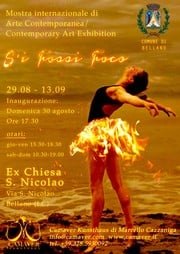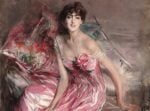S’i Fossi Foco

Gli artisti attraverso le loro opere esprimono la loro voglia di cambiamento. L’arte è il loro mezzo per modificare la realtà e il modo che tutti noi abbiamo di vederla.
Comunicato stampa
Secondo Heraclito il fuoco era il più importante degli elementi e l’anima la considerava come un misto di acqua e fuoco
Il fuoco è l’elemento più alieno, quello che più di altri incute timore per la sua forza distruttiva ma anche seducente.
Questo elemento come gli altri si presta a mille similitudini e metafore e condurrà lo spettatore, attraverso un susseguirsi di opere d’arte, in un mondo fatto di luce, calore e passione.
Senza il fuoco tutto sarebbe oscuro ed immobile, senza la sua luce non esisterebbero nemmeno i colori e forse nemmeno l’arte.
Dinamismo e calore sono due concetti indivisibili, la temperatura di un corpo è data dalla velocità degli elettroni che compongono i singoli atomi. Il fuoco è quindi un attivatore è la scintilla che mette in moto i corpi ma anche lo spirito che anima questi corpi. Questa pulsione nell’uomo è chiamata passione e viene declinata in innumerevoli accezioni, da quelle più carnali a quelle più alte come il sacro fuoco dell’arte, quella passione quasi sacra, una sorta di devozione verso uno scopo più alto e nobile. Il fuoco è conoscenza illumina le menti e riscalda i cuori, una conoscenza di un livello superiore meno materiale meno legato alla parte inconscia e più a quella trascendente.
Le fiamme nella loro apparenza appaiono mutevoli capaci di mostrarsi in infinite forme e colori, allo stesso modo verranno proposte opere d’arte diversissime tra loro, per forme, colori, poetica e intenti, ma con di fondo la stessa scintilla, la stessa fiamma, la stessa passione che accomuna tutti gli artisti e forse anche tutte le persone, quella pulsione irrefrenabile ad esprimere se stessi.
Gli artisti attraverso le loro opere esprimono la loro voglia di cambiamento. L’arte è il loro mezzo per modificare la realtà e il modo che tutti noi abbiamo di vederla
Essi gettano luce sulla società moderna o sull’uomo e ci infondono l’energia totale per riflettere ma anche per agire. Come scrisse Picasso “l’artista è un essere politico che vive eventi strazianti, impetuosi o felici a cui risponde in ogni modo...la pittura non è fatta per decorare gli appartamenti. E’ uno strumento di guerra per l’attacco e la difesa contro il nemico. L’artista vive il proprio ruolo (spesso) come un combattente di prima linea, e spesso come un fabbro o un alchimista in grado di trasformare energie ed elementi presi dal proprio background per trasformarli in qualcosa di più universale e in grado di illuminare le menti altrui. E’ maestro nel saper ben utilizzare il crogiuolo interiore di emozioni che ribolle per farne un uso saggio e dotto.
Se anche noi camminando attraverso la mostra riusciamo ad avere un pensiero creativo saremo in grado di bruciare i sentieri passati, i pensieri passati che non ci servono più, per illuminarci per farci proseguire nel nostro percorso evolutivo e di crescita. Tutto questo è possibile anche attraverso l’arte in quanto è lessico dell’essere
Questo elemento più di altri rappresenta le contraddizioni, è il solo che riesce a fondere e a unire i contrari, grazie al fuoco, viaggeremo anche attraverso le contraddizioni del mondo moderno, del carattere distruttivo dell’uomo che e comune al fuoco. Per questo motivo è l’elemento che più ci spaventa ma che al contempo ci affascina e ipnotizza con forme sinuose, luccicanti quasi vive.
Comprendere la vitalità del fuoco è comprendere la passione che sta in profondità all’atto artistico, una esigenza forte e incontenibile di comunicazione, di azione, di mutamento, ma non solo, attraverso il fuoco c’è l’estrema rigenerazione, attraverso un cammino di ricerca spirituale si arriva alla sublimazione del sè in uno stato in cui l’involucro che ci contiene non ha più importanza e viene distrutto, è in questo modo che si entra in contatto con lo spirito che molti definiscono il fuoco interiore dell’uomo.
Quella del fuoco è una conoscenza più penetrante più complicata da comprendere e da vivere a causa delle continue contraddizioni in essa esistente. E’ infatti il fuoco che arde nelle profondità delle cose a scorgere i mutamenti della natura.
L’arte è come questo fuoco è una forza pura che deve servire allo sviluppo e all’affinamento dell’anima.
If I Were Fire
According to Heraclito, fire is the most important one among the elements. He considered the soul like a compound of water and fire.
Fire is the more averse element that, more than others, strikes fear into people for its destructive force but it is also able to seduce.
This element, such as the other ones too, is perfect for thousand of similes and metaphors and it guides us into a world made of light, heat, passion and art.
Without the fire everything would be darken and immovable, without its light colors would not exist anymore and not even the art.
Dynamism and heat are two indivisible concepts, the temperature of a body are given by the speed of the electrons composing single atoms. The fire is therefore an activator: it is the spark that starts up the bodies but also the spirit that animates the same bodies. Men call such instinct “passion” and it is declined in numberless of meanings, starting from the sexual ones up to the highest ones like the sacred fire of the art: a devotion towards a higher and more noble scope.
Fire is knowledge: it illuminates minds and it heats the hearts, through an an advanced immaterial level, not tied to our unconscious part but more to that transcendent one.
The flames appear like strange entities able to an unstoppable change and to show themselves in infinite forms and colors; in the same way we propose very different artworks: forms, colors, poetics and proposals; but we like underlying the same spark,the same flame, the same passion links the artists and the people watching their artworks.
The artists express their passion through their works. The art is both their means in order to modify the truth and the way all we have to see it.
They throw light on the modern society, on the mankind and they instill us the energy in order to reflect but also in order to act .
Pablo Picasso wrote: ““the artist is a political that lives heartbreaking events, impetuous or happy to which he answers anyway… the paintings is not made in order to decorate the apartments. It is an instrument of war for it is an attack weapon and also the defense against the enemy.”
Artists live their own role (often) like a front line fighter and often as a smith or an alchemist able to transforming energies and elements taken from his own background in order to transform them in something more universal which is able to to illuminate other people's minds. An artist is a master able to to use its own tangle of emotions in order to make a lesson for everybody.
If walking through the exhibition we will also succeed to have a creative thought we will be able to burn the passed paths and the passed thoughts that do not serve us more, in order to continue in our evolution process of growing. All this is possible only through the art that is the vocabulary of the being.
More than other elements the fire represents contradiction: it is the only one able to melt and to join the opposites. Thanks to it we will travel through the contradictions of the modern world visiting the destructive characteristics of the human being. For its destroying peculiarities this element is the most scaring one but, that at the same time, it fascinates and hypnotizes us with sinuous, shimmering forms, almost alive.
To understand the vitality of the fire is vital that the deeply animating passion of the artistic action is to be understood: a strong and uncontrollable need of communicating, an action, a change; but not only through the burning fire the extreme regeneration is attainable in fact a spiritual path is also needed. In that way we are able to sublimate yourself to reach a spiritual condition in which the envelope containing ourselves ceases to matter. That’s the only way to come into contact with the spirit which people define the inner fire of the man.
The fire knowledge is much more penetrating but much more complicated to be understood because of the continuous contradictions in itself.
Art is like this fire, it is a pure force, a necessity to the development and the sharpening of the spirit.



